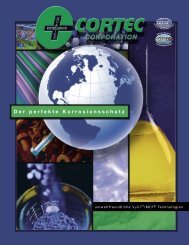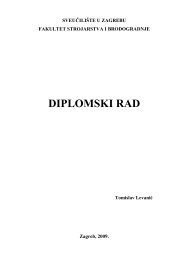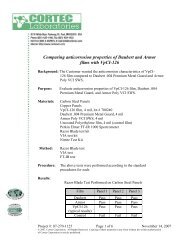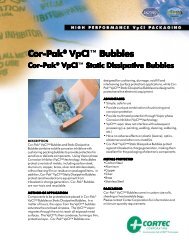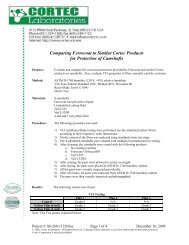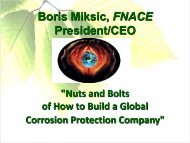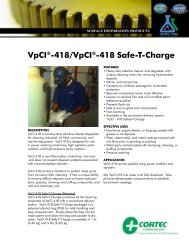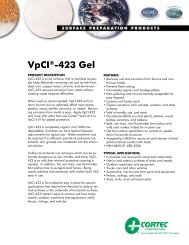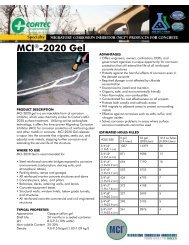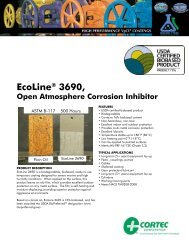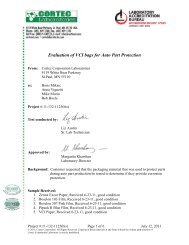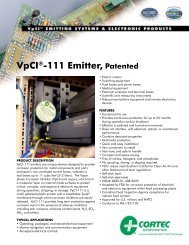Corrosion and Iron meteorites = RUST
Corrosion and Iron meteorites = RUST
Corrosion and Iron meteorites = RUST
Create successful ePaper yourself
Turn your PDF publications into a flip-book with our unique Google optimized e-Paper software.
<strong>Corrosion</strong> <strong>and</strong> <strong>Iron</strong> <strong>meteorites</strong> = <strong>RUST</strong><br />
"NANTAN" is synonymous with<br />
rust, corrosion <strong>and</strong> a deteriorating<br />
meteorite. It has earned a very bad<br />
reputation as an "instant ruster" with<br />
little hope for a cure. No serious<br />
collector wants to own a constantly<br />
deteriorating specimen.<br />
The list of other rusting irons is<br />
well known. Now there is a solution<br />
to this age old problem. A new technology<br />
prevents ionic vapor phase<br />
corrosion by providing a monomolecular<br />
protective film layer bonded<br />
to the meteorite surface. When you<br />
stop vapor moisture transmission to<br />
a substrate, you stop its ability to<br />
corrode.<br />
From the Paleo-Bond research<br />
laboratory at Uncommon Conglomerates<br />
Inc., comes a technology<br />
developed with rusting <strong>meteorites</strong> in<br />
mind. Working in cooperation with<br />
Cortec® Corporation, which developed<br />
anti-corrosion systems for the<br />
military, we are able to stop cold the<br />
corrosion of the iron <strong>meteorites</strong> in<br />
your collection.<br />
A "Getting Started Kit" is available<br />
that will permit you to de-rust<br />
an iron meteorite in your own shop.<br />
Then coat it to prevent corrosion.<br />
If you should chose not to coat your<br />
specimen, we have emitters that will<br />
stop rust in your display cases.
THE<br />
PROCESS<br />
SPECIAL NOTE:<br />
If you purchased a meteorite<br />
coated with an unidentified<br />
clear coat <strong>and</strong> rust is<br />
observed, chances are it is<br />
rusting under the coating.<br />
You will have to remove the<br />
coating chemically to get at<br />
the rust. Vapor moisture<br />
transmission through poorly<br />
formulated coatings means<br />
<strong>RUST</strong>.<br />
SAFETY FIRST<br />
We recommend using<br />
safe practices when<br />
h<strong>and</strong>ling kit materials<br />
• Plastic Nitril Gloves<br />
• Safety Glasses<br />
• Plastic Apron<br />
• Paper Towels<br />
• Polyethylene Table<br />
Cover <strong>and</strong> Utensils<br />
CLEANING If your meteorite has rust, <strong>and</strong> is<br />
either a big guy or just a slice, it can be cleaned<br />
<strong>and</strong> restored to its' former un-rusted self. To<br />
accomplish this, you will need a combination of<br />
mechanical <strong>and</strong> chemical tools. Your mechanical<br />
tools range from air chipper hammers, microblasters,<br />
a putty knife, <strong>and</strong> then abrasive s<strong>and</strong>ing <strong>and</strong><br />
polishing. BUT all of this is a waste of time without<br />
chemical interaction to do the present cleaning <strong>and</strong><br />
to assure that re-occurrence of rust never happens.<br />
Chemicals are used to dissolve corrosion<br />
residue (rust) <strong>and</strong> to prevent it's reoccurrence.<br />
<strong>Corrosion</strong> in <strong>meteorites</strong> is the result of outearth's<br />
chemistry that greets the visitor from outer<br />
space. Combining with the ferrous element in<br />
Galvanic action at the exterior surface of the meteorite<br />
<strong>and</strong> the boundary with the outside atmosphere.<br />
A meteorite held in a vacuum will never corrode.<br />
For corrosion to proceed, you must have air,<br />
water <strong>and</strong> a few other gases. Just consider that the<br />
corroding metal is trying to return to its' former<br />
ore status.<br />
For chemical cleaning we'll use a few unique<br />
ACID cleaners. The first is a thin liquid that penetrates<br />
into the surface <strong>and</strong> down into cracks. The<br />
second is a gel that sits <strong>and</strong> works on tough, builtup<br />
rust areas. Use the nylon scrub brush <strong>and</strong> the<br />
putty knife to help in removal of the oxides. The big<br />
difference with our chemistries is that they contain<br />
a patented formula that stops Galvanic action. It's<br />
called a "Vapor phase <strong>Corrosion</strong> Inhibitor" This<br />
VpCl is in all our supporting products. They are both<br />
environmentally friendly <strong>and</strong> safe to use. After the<br />
acid cleaning, neutralize any trace of the acid. Again,<br />
VpCI compounds are build into the neutralizer.<br />
DRY your meteorite in an oven at 150°F for an<br />
hour. This will get rid of any remaining moisture that<br />
may be present. Let it cool to room temperature.<br />
ETCHING your meteorite is possible now with<br />
either Nitol or Ferric Chloride solutions.<br />
NEUTRALIZE the Acid Etching solutions <strong>and</strong> dry<br />
your specimen.<br />
COATING with our special formula clear acrylic<br />
solution with VpCI will give you a beautiful finished<br />
meteorite.
METEORITE<br />
<strong>RUST</strong> REMOVAL AND<br />
PRESERVATION KIT<br />
LARGER QUANTITIES AVAILABLE...CALL<br />
For sales or technical service contact: Bill Mason III<br />
Uncommon Conglomerates<br />
PALEO-BOND DIVISION<br />
St. Paul, MN 55103<br />
© 2005 UCI<br />
This is a "Getting Started Kit" for your initial<br />
work in controlling corrosion in <strong>meteorites</strong>.<br />
The price of the kit is $50.00.<br />
THE KIT CONTAINS:<br />
• 4 oz.VCI 426 Liquid Acid<br />
• 4 oz.VCI 426 Gel Acid<br />
• 4 oz.VCI 416 Acid Neutralizer (concentrate)<br />
A rust preventive for sawing <strong>and</strong> grinding solutions.<br />
• 4 oz. M 435 (concentrate)<br />
• 12 oz.VCI 286 Clear Coating Aerosol<br />
• Nylon Scrub Brush<br />
• Acid Application Brush<br />
• Pipette Applicator<br />
• Polyethylene Cups<br />
• VpCI Zip lock bags<br />
• 3M Scotch Brite® Pad<br />
• Detailed Instructions<br />
1-800-323-4545 cell 612-840-709<br />
E-mail: bmason3@comcast.net<br />
or paieobond@popp.net<br />
Website: www.paleobond.com
Detailed Process for Rust Removal<br />
& Preservation<br />
THE METEORITE SPECIMEN<br />
A sliced individual specimen is relatively<br />
easy to work on, depending<br />
of course on the size. Small pieces<br />
can be dipped <strong>and</strong> scrubbed of<br />
their oxidation using a plastic cake<br />
tray. BIG Slices are a different matter.<br />
Prepare them one side at a time<br />
<strong>and</strong> stick with the project until<br />
both sides are completed. Cover<br />
your work table with polyethylene<br />
plastic sheet. Cut three small wood<br />
blocks to act as a platform for<br />
your specimen. Clean the backside<br />
first [usually the uns<strong>and</strong>ed side<br />
with saw marks visible] If you treat<br />
big slices one side at a time a better<br />
overall final result is achieved.<br />
Step #1 - Rust Removal with VCI<br />
426 Acids (Liquid <strong>and</strong> Gel). Start<br />
with an examination of the specimen.<br />
If it has rust that measurably<br />
sits on top of the surface, take a<br />
sharp putty knife <strong>and</strong> scrape the<br />
rust aside. Next, apply the VCI-426<br />
Liquid Acid with a brush. Let it<br />
work until you are satisfied the rust<br />
is gone [20 minutes+]. Where the<br />
rust is deep, use the VCI-426 Gel.<br />
It has a slow rate of evaporation<br />
allowing the acid to penetrate deep<br />
into the rust. Use the stiff nylon<br />
brush in your kit to scrub the rusted<br />
spots. If you have a deep pit of<br />
rust, use an air abrade tool to get<br />
down to the un-rusted base surface.<br />
Flush with acid again.<br />
Step #2 - Wash off the acids with<br />
water. Use bottled water without<br />
chlorine. We discovered that using<br />
neutraiizer immediately after the acid<br />
cleaning left a slight white residue.<br />
Washing first eliminated this.<br />
Step #3 - Neutralize acid with<br />
VCI 416. This step does several<br />
things; first, it neutralizes the acid<br />
on or in your meteorite. It also<br />
allows you to take a break in your<br />
processing. The VpCI additive in the<br />
neutraiizer stops any corrosion for<br />
a coupie of months. You don't have<br />
to rush to the next processes.<br />
Step #4 - Drying. Oven dry your<br />
specimen at 150°f [70°C). Bake for<br />
60 minutes. Obviously, if the specimen<br />
is a BIG boulder, it will take a<br />
long time to heat through. If your<br />
meteorite is dry - it will not rust.<br />
Set aside to cool for final process.<br />
Step #5 - Coating.VCI 286,<br />
Aerosol Spray Clear Coat. This final<br />
coating will build a monomolecular<br />
protective barrier that prevents any<br />
vapor moisture transmission into<br />
the meteorite surface. The all-important<br />
VpCI/MCI chemistries provide<br />
the needed protection that prevents<br />
further galvanic corrosive action.<br />
Meteorite slab finishing:<br />
Preparing a surface for etching is<br />
simple if you go through a sequence<br />
of abrasives, 280-400-600-1200<br />
grit. Guidance details upon request.<br />
ETCHING with either Nitol solution<br />
or Ferric Chloride should be done<br />
between steps #2 <strong>and</strong> #3. Again,<br />
help is available.<br />
VCI-M435. A new product for<br />
preventing rust during cutting,<br />
grinding or s<strong>and</strong>ing operations. It<br />
will keep laps from rusting <strong>and</strong> your<br />
meteorite from rusting while in the<br />
processing sequence over a period<br />
of weeks <strong>and</strong> months. Add to cutting<br />
fluids <strong>and</strong> coolants. VCI-M 435<br />
will be your new best friend.



